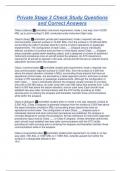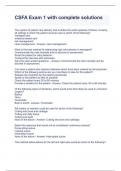Private Stage 2 Check Study Questions
and Correct Answers
Class a (above) ✅controlled; instrument requirement; mode c; two way; from 18,000'
MSL up to and including FL 600; conducted under instrument flight rules
Class b (busy) ✅controlled; private pilot requirement; mode c required; two way
communication required; surface to 10,000' MSL; from the surface to 10,000 feet MSL
surrounding the nation's busiest airports in terms of airport operations or passenger
enplanements. The configuration of each Class ___ airspace area is individually
tailored, consists of a surface area and two or more layers (some Class ___ airspace
areas resemble upside-down wedding cakes), and is designed to contain all published
instrument procedures once an aircraft enters the airspace. An ATC clearance is
required for all aircraft to operate in the area, and all aircraft that are so cleared receive
separation services within the airspace.
Class c (communicate) ✅controlled; student pilot requirement; mode c required; two
way communication required; surface to 4,000' AGL; from the surface to 4,000 feet
above the airport elevation (charted in MSL) surrounding those airports that have an
operational control tower, are serviced by a radar approach control, and have a certain
number of IFR operations or passenger enplanements. Although the configuration of
each Class ___ area is individually tailored, the airspace usually consists of a surface
area with a five NM radius, an outer circle with a ten NM radius that extends from 1,200
feet to 4,000 feet above the airport elevation, and an outer area. Each aircraft must
establish two-way radio communications with the ATC facility providing air traffic
services prior to entering the airspace and thereafter maintain those communications
while within the airspace.
Class d (dialogue) ✅controlled; student pilot; no mode c; two way required; surface to
2,500' AGL; Class D airspace is generally airspace from the surface to 2,500 feet above
the airport elevation (charted in MSL) surrounding those airports that have an
operational control tower. The configuration of each Class ___ airspace area is
individually tailored and when instrument procedures are published, the airspace is
normally designed to contain the procedures. Arrival extensions for instrument approach
procedures (iaps) may be Class ___ or Class E airspace. Unless otherwise authorized,
each aircraft must establish two-way radio communications with the ATC facility
providing air traffic services prior to entering the airspace and thereafter maintain those
communications while in the airspace.
Class e (everywhere else) ✅controlled; student pilot requirement; no mode c; no two
way radio; 700' AGL or 1200' MSL to 17,999' AGL; extends upward from either the
surface or a designated altitude to the
14-2
,Overlying or adjacent controlled airspace. When designated as a surface area, the
airspace is configured to contain all instrument procedures. Also in this class are federal
airways, airspace beginning at either 700 or 1,200 feet above ground level (AGL) used
to transition to and from the terminal or en route environment, and en route domestic
and offshore airspace areas designated below 18,000 feet MSL. Unless designated at a
lower altitude, Class ___ airspace begins at 14,500 MSL over the United States
Class g (ground, go for it) ✅uncontrolled; student pilot requirement; no mode c; no two
way radio; surface to 1200' AGL; surface to 700' AGL; sometimes 14500' MSL;
uncontrolled airspace; extends from the surface to the base of the overlying Class E
airspace. Although ATC has no authority or responsibility to control air traffic, pilots
should remember there are visual flight rules (VFR) minimums which apply to Class G
airspace.
91.155 (VFR WX min) day: 1 sm vis, distance from clouds 500' below 1000' above
2000' horizontal; night: vis 3 sm, distance from clouds 500' below 1000' above 2000'
horizontal ✅VFR WX minimums class g: more than 1200' above surface, less than
10,000' MSL
91.155 (VFR WX min) day: vis 1 sm, distance from clouds clear of clouds; night: vis 3
sm 500' below 1000' above 2000' horizontal ✅VFR WX minimums class g: 1200' or
less above the surface
91.155 (VFR WX min) vis 3 sm, distance from clouds 500' below 1000' above 2000'
horizontal ✅VFR WX minimums class e: less than 10,000' MSL
91.155 (VFR WX min) vis 3 sm, distance from clouds 500' below 1000' above 2000'
horizontal ✅VFR WX minimums class d
91.155 (VFR WX min) class e, vis 5 sm, distance from clouds 1000' below 1000' above
1 sm horizontal ✅VFR WX minimums at/above 10,000' MSL
91.155 (VFR WX min) vis 3 sm, distance from clouds 500' below 1000' above 2000'
horizontal ✅VFR WX minimums class c
91.155 (VFR WX min) vis 3 sm, distance from clouds clear of clouds ✅VFR WX
minimums class b
91.155 (VFR WX min) vis n/a, distance from clouds n/a ✅VFR WX minimums class a
91.155 (VFR WX min) vis 5 sm, distance from clouds 1000' below 1000' above 1 sm
horizontal ✅VFR WX minimums class e more than 1200' above the surface, at or
above 10,000' MSL
Standard, abbreviated, outlook ✅types of weather briefings
, Standard briefing ✅
Abbreviated briefing ✅Request this when you need information to supplement other
electronically acquired data (for
Example, TIBS or DUAT) or update a previous briefing or when you need only one or
two specific items. Provide
The briefer with appropriate background information, the time you received the previous
information, and the
Specific items needed. You should indicate the source of the information already
received so that the briefer can
Limit the briefing to the information that you have not received and provide significant
changes in meteorological conditions or aeronautical information since your previous
briefing.
Outlook briefing ✅Request an outlook briefing whenever your proposed time of
departure is 6 or more hours in the future. In this
Case, the briefer will provide you with available forecast data applicable to your
proposed departure time. This
Type of briefing is provided for planning purposes only.
NOTAM ✅notice to airmen
Special use airspace ✅is used to confine certain flight activities and to place limitations
on aricracft operations which are not part of these activities
Alert areas, warning areas, restricted areas, prohibited areas, national security areas,
military operations areas, controlled firing areas ✅special use airspace is divided into
Alert areas (unusual aerial activity) ✅areas shown on aeronautical charts to inform you
of unusual types of aerial activities, such as parachute jumping, glider towing, or high
concentrations of student pilot training; responsibility for collision avoidance in ___ rests
with all pilots
Military operations areas (MOA) ✅is a block or airspace in which military training and
other military maneuvers are conducted; usually have specified floors and ceilings for
containing military activities; VFR a/c aren't prevented from flying through active ___s
but is wise to avoid them when possible; flight service stations w/in 100 nautical miles of
a __ are provided with info regarding the hours of operation
Warning areas (hazardous activity, aerial gunnery/guided missiles) ✅is airspace of
defined dimensions, extending from three nautical miles outward from the coast of the
US, that contains activity which may be hazardous to nonparticipating pilots of the
potential danger; not depicted on aeronautical charts to caution nonparticipating pilots of





